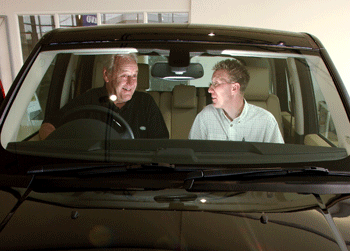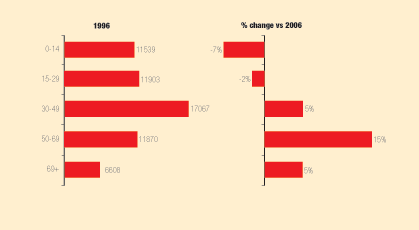Retailers and carmakers should be fighting tooth and nail for customers, but many are ignoring the needs of more than 40% of the car buying population.
Who are these people who feel undervalued and unloved by the automotive industry? The over-50s.
AM published a feature 2½ years ago urging retailers and carmakers to start engaging and understanding the over-50s. We pointed out that these people accounted for two-thirds of retail sales, but were being put off by pushy salesmen and irrelevant car ads. It seems that little has changed. New research reveals that retailers and manufacturers are still spurning the opportunity to tap into this valuable source of revenue.
The over-50s will number more than 20m next year, a third of the total population and around 40% of the approximate 48m possible car buyers. They hold 80% of the nation’s wealth and are spending £240m per year on consumer goods. And get this: they tend to be unaffected by housing prices and other economic indicators that affect other retail buyers.
By 2020, Government projections put the number of over-50s at 25m, around half the adult population. Research by Age Concern shows that these older, richer and fitter people are increasingly moving into a ‘buy now, worry later’ mind set. Only a quarter say they would rather save their money; 46% would rather spend it. And they do: the over-50s now owe more relative to their income than younger people.

#AM_ART_SPLIT# Age Concern believes business needs to ditch stereotypes about timid and unadventurous older consumers.
“Marketeers and businesses so rarely design, create and promote products with older people in mind and it’s a wasted opportunity,” says Dr David Metz, co-author of Older, richer fitter, a guide to understanding the grey market. “We’re living in a spending culture with a demographic balance that is tipped towards older people. What are they waiting for?”
What do these people – often referred to as silver surfers, grey pounders and, in some cases, people who have Stopped Working And Now Spending (SWANS) – want from car retailers and carmakers?
“SWANS are intelligent and lively consumers who, given the time and attention they need, will become positively engaged with brands,” says Mark Smith, group account director of WDMP. “Many SWANS are in the market to buy a brand new car that they perceive to be reliable, safe and has a certain standing and status that reflects their comfortable retirement.”
WDMP interviewed 50 over-50s to assess their views of the motor industry. They are looking for specifications, safety and status in their car purchases, but also demand comfort, cost-effective servicing and a fair price. Aftersales and first-rate customer service are prime concerns.
Over-50s appreciate sales staff who take the time to discuss things in depth and allow them to make their own decision based on knowledgeable consideration, but many complain of poor service, lack of courtesy and patronizing tones.
Given good service, recognition and a reason to return, and they are extremely brand loyal. Fail to meet their needs and they are surprisingly brand promiscuous.
“Far from being fuddy-duddy, spend thrift and suspicious of marketing, SWANS are in fact close in attitude to people in their 30s and 40s. They certainly don’t see themselves as elderly and refute niche brands for older people,” says Smith.
Despite this, the over-50s do not aspire to a youth brand. They want to be included in mass-market advertising but communicated to in their own language. These are people who spend more on average buying and maintaining cars than any other household group.
#AM_ART_SPLIT#
Retirement often sparks a change in car brand and model, with choices often polarizing at two extremes: downsizing to a cost-effective car, or indulging in a premium ‘ideal’ car. Many are buying a new car for the first time, so their initial experience at the dealership will shape their perception: capture them at this point, and guarantee up to 20 years of purchasing and servicing income.
More than one in five (22%) of 50-69-year-olds say having a good car is one of the most important things in life. They trust their family, car magazines, friends and local garages to provide them with best advice but, increasingly, they are using the internet for information.
Put ‘over-50s’ into the search engine and find a host of websites dedicated to their needs, offering everything from car reviews to choosing the right vehicle to finance and insurance.
Auto Trader says a rising proportion of its website users are the over-50s. But there’s a new source targeting them too. Teletext, described as the grey market equivalent of the internet, has launched a new and used car buying service. Targeted adverts, including slots on Classic FM radio, claim to have signed up more than 2,000 dealers to provide stock.
Case study
The Skills Analysis Development Partnership has launched a toolkit to tackle age discrimination and promote the benefits of over-50s workers.
The organization, funded by the Equal initiative through the European Social Fund, has pinpointed car retail as one of three priority sectors. It aims to influence employers in the recruitment and retention of older workers by identifying hidden competencies that are being under exploited by retailers.
The toolkit matches competence to specific requirements and compares them to those seen as desirable or essential for the sector or organization.
It identifies and quantifies competencies if the person is seeking new employment, or contributes to personal development plans.
Older workers offer retailers expertise, skills, knowledge and the right attitude.
Five sales tips
Ageing population 10-year trend

The over-50s is the fastest growing segment of the population. They are expected to represent more than 20m next year, one-third of the population and 40% of adults.













Login to comment
Comments
No comments have been made yet.